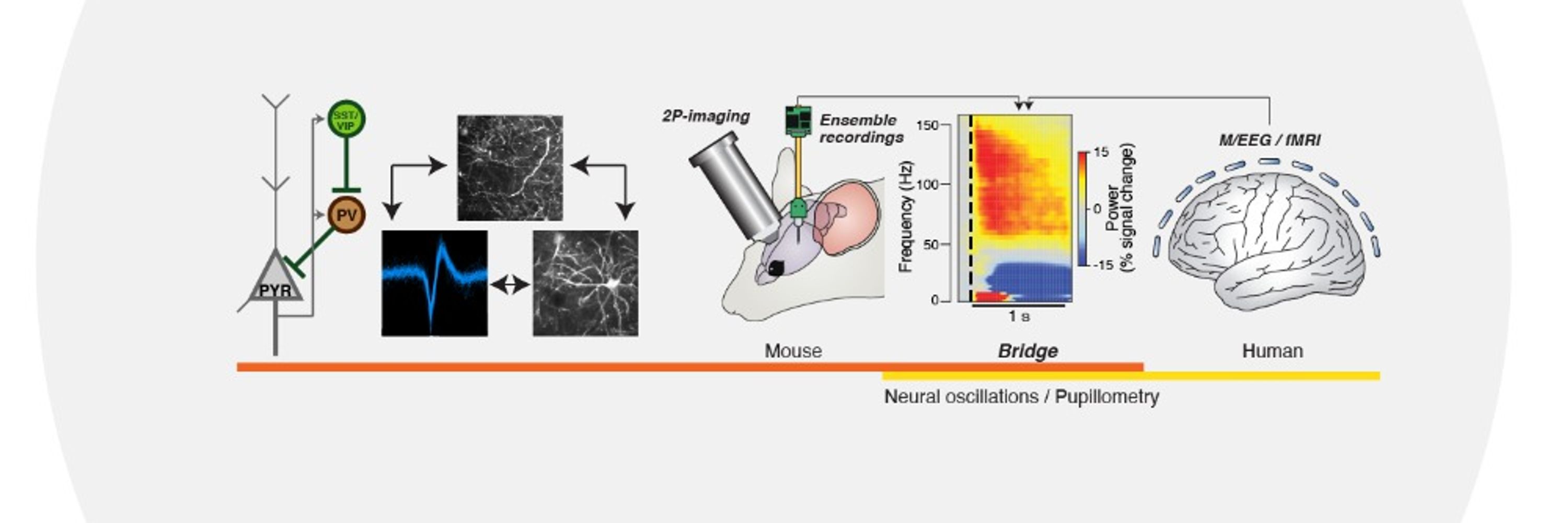
de Gee lab
@degeelab.bsky.social
Assistant Professor of Cognitive and Systems Neuroscience @ University of Amsterdam. Studying how arousal states shape perception and decision-making in humans and mice.
http://www.janwillemdegee.info
http://www.janwillemdegee.info
Reposted by de Gee lab
Thrilled that our paper is out today in Nature!
www.nature.com/articles/s4...
www.nature.com/articles/s4...

Sensory expectations shape neural population dynamics in motor circuits
Nature - Experiments with human volunteers and macaques show that expectations produced by probabilistic cueing of future sensory inputs shape motor circuit dynamics in order to increase the...
www.nature.com
October 29, 2025 at 4:11 PM
Thrilled that our paper is out today in Nature!
www.nature.com/articles/s4...
www.nature.com/articles/s4...
Reposted by de Gee lab
🧠 Regularization, Action, and Attractors in the Dynamical “Bayesian” Brain
direct.mit.edu/jocn/article...
(still uncorrected proofs, but they should post the corrected one soon--also OA is forthcoming, for now PDF at brainandexperience.org/pdf/10.1162-...)
direct.mit.edu/jocn/article...
(still uncorrected proofs, but they should post the corrected one soon--also OA is forthcoming, for now PDF at brainandexperience.org/pdf/10.1162-...)

Regularization, Action, and Attractors in the Dynamical “Bayesian” Brain
Abstract. The idea that the brain is a probabilistic (Bayesian) inference machine, continuously trying to figure out the hidden causes of its inputs, has become very influential in cognitive (neuro)sc...
direct.mit.edu
October 22, 2025 at 8:59 AM
🧠 Regularization, Action, and Attractors in the Dynamical “Bayesian” Brain
direct.mit.edu/jocn/article...
(still uncorrected proofs, but they should post the corrected one soon--also OA is forthcoming, for now PDF at brainandexperience.org/pdf/10.1162-...)
direct.mit.edu/jocn/article...
(still uncorrected proofs, but they should post the corrected one soon--also OA is forthcoming, for now PDF at brainandexperience.org/pdf/10.1162-...)
Reposted by de Gee lab
@dotproduct.bsky.social's first first author paper is finally out in @sfnjournals.bsky.social! Her findings show that content-specific predictions fluctuate with alpha frequencies, suggesting a more specific role for alpha oscillations than we may have thought. With @jhaarsma.bsky.social. 🧠🟦 🧠🤖

Contents of visual predictions oscillate at alpha frequencies
Predictions of future events have a major impact on how we process sensory signals. However, it remains unclear how the brain keeps predictions online in anticipation of future inputs. Here, we combin...
www.jneurosci.org
October 21, 2025 at 11:05 AM
@dotproduct.bsky.social's first first author paper is finally out in @sfnjournals.bsky.social! Her findings show that content-specific predictions fluctuate with alpha frequencies, suggesting a more specific role for alpha oscillations than we may have thought. With @jhaarsma.bsky.social. 🧠🟦 🧠🤖
Reposted by de Gee lab
Online Now: Hierarchical interactions between sensory cortices defy predictive coding

Hierarchical interactions between sensory cortices defy predictive coding
Perceptual experience depends on recurrent interactions between lower and higher cortices. One theory, predictive coding, posits that feedback from higher to lower brain regions decreases neuronal activity predicted by higher-level representations. Despite the widespread adoption of predictive coding in neuroscience, the correspondence to neurophysiological findings in sensory cortices remains elusive. Here, we review how the canonical patterns of intra- and inter-cortical interactions that occur during perception and shifts of attention deviate from those predicted by predictive coding. We argue that these circuit interactions are better captured by alternative theories, which we summarize under the umbrella term BELIEF. We review how BELIEF theories account for the inter-areal interactions during attentive perception.
dlvr.it
October 20, 2025 at 7:04 PM
Online Now: Hierarchical interactions between sensory cortices defy predictive coding
Reposted by de Gee lab
Decoding performance (MVPA) better for OPM-MEG than SQUID-MEG 😎. The improved spatial specificity of OPM-MEG due to the reduced brain-sensor distance is key. And more sensors (beyond 40) don't improve decoding.
Preprint from our recent @thechbh.bsky.social study: www.biorxiv.org/content/10.1...
Preprint from our recent @thechbh.bsky.social study: www.biorxiv.org/content/10.1...

Decoding with multivariate pattern analysis is superior for optically pumped magnetometer-based magnetoencephalography compared to superconducting quantum interference device-based systems
Background: Multivariate pattern analysis (MVPA) has become an increasingly important method for decoding distributed brain activity from neural electrophysiological recordings by leveraging both temp...
www.biorxiv.org
October 16, 2025 at 12:13 PM
Decoding performance (MVPA) better for OPM-MEG than SQUID-MEG 😎. The improved spatial specificity of OPM-MEG due to the reduced brain-sensor distance is key. And more sensors (beyond 40) don't improve decoding.
Preprint from our recent @thechbh.bsky.social study: www.biorxiv.org/content/10.1...
Preprint from our recent @thechbh.bsky.social study: www.biorxiv.org/content/10.1...
Reposted by de Gee lab
How does motivation shape learning and memory? In a new review w @ralisonadcock.bsky.social, we propose that under different motivational ‘moods', neuromodulators set distinct neural contexts to determine information processing and memory formation.
doi.org/10.1146/annu...
#psychscisky #neuroskyence
doi.org/10.1146/annu...
#psychscisky #neuroskyence

Motivation as Neural Context for Adaptive Learning and Memory Formation
Our memories shape our perception of the world and guide adaptive behavior. Rather than a veridical record of experiences, memory is selective. An accumulating body of work suggests that motivational ...
www.annualreviews.org
October 13, 2025 at 4:09 AM
How does motivation shape learning and memory? In a new review w @ralisonadcock.bsky.social, we propose that under different motivational ‘moods', neuromodulators set distinct neural contexts to determine information processing and memory formation.
doi.org/10.1146/annu...
#psychscisky #neuroskyence
doi.org/10.1146/annu...
#psychscisky #neuroskyence
Reposted by de Gee lab
The brain is incredibly densely connected. Human cerebral cortex may have as many as *one trillion* connections.
Most of those cortical connections are recurrent, inside each area. What do they do?
New paper from me in Annual Reviews: 🧪 🧠📈 1/
www.annualreviews.org/content/jour...
Most of those cortical connections are recurrent, inside each area. What do they do?
New paper from me in Annual Reviews: 🧪 🧠📈 1/
www.annualreviews.org/content/jour...
Active Filtering: A Predictive Function of Recurrent Circuits of Sensory Cortex | Annual Reviews
Our brains encode many features of the sensory world into memories: We can sing along with songs we have heard before, interpret spoken and written language composed of words we have learned, and reco...
www.annualreviews.org
September 25, 2025 at 7:35 PM
The brain is incredibly densely connected. Human cerebral cortex may have as many as *one trillion* connections.
Most of those cortical connections are recurrent, inside each area. What do they do?
New paper from me in Annual Reviews: 🧪 🧠📈 1/
www.annualreviews.org/content/jour...
Most of those cortical connections are recurrent, inside each area. What do they do?
New paper from me in Annual Reviews: 🧪 🧠📈 1/
www.annualreviews.org/content/jour...
Reposted by de Gee lab
Our spotlight article on Goueytes et al. (2025) study is now online at Trends in Neurosciences: "Pre- and post-decision signals of certainty in changing minds", by P. Barttfeld, @ncomay.bsky.social, I. Embon & @guillermosolovey.bsky.social www.cell.com/trends/neuro...

Pre- and post-decision signals of certainty in changing minds
In a recent study, Goueytes and colleagues combined computational modeling with intracranial
recordings to dissect the neural basis of confidence and changes of mind. They reveal
a temporally organize...
www.cell.com
October 9, 2025 at 1:22 PM
Our spotlight article on Goueytes et al. (2025) study is now online at Trends in Neurosciences: "Pre- and post-decision signals of certainty in changing minds", by P. Barttfeld, @ncomay.bsky.social, I. Embon & @guillermosolovey.bsky.social www.cell.com/trends/neuro...
Reposted by de Gee lab
Finally out: our recent work with Nick Betley is a view into how the brain reshapes its behavior in the face of competing survival needs- and also a potential angle on treatment targets for enduring pain.
A brief rundown...
www.nature.com/articles/s41...
A brief rundown...
www.nature.com/articles/s41...

A parabrachial hub for need-state control of enduring pain - Nature
Activity in a set of parabranchial neurons in the mouse brain is increased during chronic pain, predicts coping behaviour, and can be modulated by circuits activated by survival threats.
www.nature.com
October 9, 2025 at 1:15 PM
Finally out: our recent work with Nick Betley is a view into how the brain reshapes its behavior in the face of competing survival needs- and also a potential angle on treatment targets for enduring pain.
A brief rundown...
www.nature.com/articles/s41...
A brief rundown...
www.nature.com/articles/s41...
Reposted by de Gee lab
🎇 Excited to finally share JL Romero Sosa’s publication! Results are from single-cell imaging in different subregions of rat frontal cortex during ✨de novo learning. Spoiler: everything is not everywhere all at once www.nature.com/articles/s41...

Neural coding of choice and outcome are modulated by uncertainty in orbitofrontal but not secondary motor cortex - Nature Communications
Neural mechanisms underlying flexible learning and decision-making are not fully understood. Using single-cell calcium imaging, authors here found that neurons in orbitofrontal and secondary motor cortex exhibit complementary roles in reward learning, with neurons in the former exerting a sustained role in conditions of uncertainty.
www.nature.com
October 8, 2025 at 12:33 PM
🎇 Excited to finally share JL Romero Sosa’s publication! Results are from single-cell imaging in different subregions of rat frontal cortex during ✨de novo learning. Spoiler: everything is not everywhere all at once www.nature.com/articles/s41...
Reposted by de Gee lab
For all the knucklehead reviewers out there.
Principles for proper peer review - Earl K. Miller
jocnf.pubpub.org/pub/qag76ip8...
#neuroscience
Principles for proper peer review - Earl K. Miller
jocnf.pubpub.org/pub/qag76ip8...
#neuroscience

Principles for proper peer review
jocnf.pubpub.org
October 6, 2025 at 7:59 PM
For all the knucklehead reviewers out there.
Principles for proper peer review - Earl K. Miller
jocnf.pubpub.org/pub/qag76ip8...
#neuroscience
Principles for proper peer review - Earl K. Miller
jocnf.pubpub.org/pub/qag76ip8...
#neuroscience
Reposted by de Gee lab
Our #sEEG study is now published in Nature Communications: rdcu.be/eIkoG! 🧠
Key finding: We discovered neural evidence accumulation for visual perception that's independent of report preparation—recorded from >3000 channels across 3 experiments!
#Neuroscience #Consciousness #OpenAccess
Key finding: We discovered neural evidence accumulation for visual perception that's independent of report preparation—recorded from >3000 channels across 3 experiments!
#Neuroscience #Consciousness #OpenAccess
September 29, 2025 at 3:27 PM
Our #sEEG study is now published in Nature Communications: rdcu.be/eIkoG! 🧠
Key finding: We discovered neural evidence accumulation for visual perception that's independent of report preparation—recorded from >3000 channels across 3 experiments!
#Neuroscience #Consciousness #OpenAccess
Key finding: We discovered neural evidence accumulation for visual perception that's independent of report preparation—recorded from >3000 channels across 3 experiments!
#Neuroscience #Consciousness #OpenAccess
Reposted by de Gee lab
Curious about the human ability to extract regularities from sensory input (i.e., “statistical learning”) and individual differences therein? #CognitiveScience #Learning
Our #Consensus paper presents the collective insights of 27 researchers worldwide 🌎 💬 🌍 💬 🌏 💬:
🔗 doi.org/10.31234/osf...
Our #Consensus paper presents the collective insights of 27 researchers worldwide 🌎 💬 🌍 💬 🌏 💬:
🔗 doi.org/10.31234/osf...


September 24, 2025 at 8:02 AM
Curious about the human ability to extract regularities from sensory input (i.e., “statistical learning”) and individual differences therein? #CognitiveScience #Learning
Our #Consensus paper presents the collective insights of 27 researchers worldwide 🌎 💬 🌍 💬 🌏 💬:
🔗 doi.org/10.31234/osf...
Our #Consensus paper presents the collective insights of 27 researchers worldwide 🌎 💬 🌍 💬 🌏 💬:
🔗 doi.org/10.31234/osf...
Reposted by de Gee lab
With 2 postdocs moving on to faculty positions🥳, we're looking to hire someone new. If you're interested in norepinephrine and neural circuits, please apply! tinyurl.com/42bfe24k
Postdoctoral Research Associate - Developmental Neurobiology
A postdoctoral research associate position is available in the laboratory of Dr. Lindsay Schwarz in the Department of Developmental Neurobiology at St. Jude Children’s Research Hospital. The Schwarz l...
tinyurl.com
September 24, 2025 at 3:41 PM
With 2 postdocs moving on to faculty positions🥳, we're looking to hire someone new. If you're interested in norepinephrine and neural circuits, please apply! tinyurl.com/42bfe24k
Reposted by de Gee lab
How do we update our predictions when our environment changes?
The hippocampus rapidly integrates previously distinct sequences to support updated predictions.
Proud of this work with Hannah Tarder-Stoll & @chrisbaldassano.bsky.social!
www.biorxiv.org/content/10.1...
The hippocampus rapidly integrates previously distinct sequences to support updated predictions.
Proud of this work with Hannah Tarder-Stoll & @chrisbaldassano.bsky.social!
www.biorxiv.org/content/10.1...

The Hippocampus Rapidly Integrates Sequence Representations During Novel Multistep Predictions
Memories for temporally extended sequences can be used adaptively to predict future events on multiple timescales, a function that relies on the hippocampus. For such predictions to be useful, they sh...
www.biorxiv.org
September 16, 2025 at 1:41 PM
How do we update our predictions when our environment changes?
The hippocampus rapidly integrates previously distinct sequences to support updated predictions.
Proud of this work with Hannah Tarder-Stoll & @chrisbaldassano.bsky.social!
www.biorxiv.org/content/10.1...
The hippocampus rapidly integrates previously distinct sequences to support updated predictions.
Proud of this work with Hannah Tarder-Stoll & @chrisbaldassano.bsky.social!
www.biorxiv.org/content/10.1...
Reposted by de Gee lab
We are hiring for several research positions for this grant, starting early next year. Please reach out if you're interested!
More details on the jobs here: devcompsy.org/wp-content/u...
More details on the jobs here: devcompsy.org/wp-content/u...
July 24, 2025 at 6:46 AM
We are hiring for several research positions for this grant, starting early next year. Please reach out if you're interested!
More details on the jobs here: devcompsy.org/wp-content/u...
More details on the jobs here: devcompsy.org/wp-content/u...
Reposted by de Gee lab
Two flagship papers from the International Brain Laboratory, now out in @Nature.com:
🧠 Brain-wide map of neural activity during complex behaviour: doi.org/10.1038/s41586-025-09235-0
🧠 Brain-wide representations of prior information in mouse decision-making: doi.org/10.1038/s41586-025-09226-1 +
🧠 Brain-wide map of neural activity during complex behaviour: doi.org/10.1038/s41586-025-09235-0
🧠 Brain-wide representations of prior information in mouse decision-making: doi.org/10.1038/s41586-025-09226-1 +

September 3, 2025 at 4:22 PM
Two flagship papers from the International Brain Laboratory, now out in @Nature.com:
🧠 Brain-wide map of neural activity during complex behaviour: doi.org/10.1038/s41586-025-09235-0
🧠 Brain-wide representations of prior information in mouse decision-making: doi.org/10.1038/s41586-025-09226-1 +
🧠 Brain-wide map of neural activity during complex behaviour: doi.org/10.1038/s41586-025-09235-0
🧠 Brain-wide representations of prior information in mouse decision-making: doi.org/10.1038/s41586-025-09226-1 +
🧠✨ Exciting new research alert! ✨🧠
Did you know that catecholamines can reduce choice history biases in perceptual decision-making? 🧐🔍
Paper: journals.plos.org/plosbiology/...
With @donnerlab.bsky.social and @swammerdamuva.bsky.social
Did you know that catecholamines can reduce choice history biases in perceptual decision-making? 🧐🔍
Paper: journals.plos.org/plosbiology/...
With @donnerlab.bsky.social and @swammerdamuva.bsky.social
September 5, 2025 at 8:05 AM
🧠✨ Exciting new research alert! ✨🧠
Did you know that catecholamines can reduce choice history biases in perceptual decision-making? 🧐🔍
Paper: journals.plos.org/plosbiology/...
With @donnerlab.bsky.social and @swammerdamuva.bsky.social
Did you know that catecholamines can reduce choice history biases in perceptual decision-making? 🧐🔍
Paper: journals.plos.org/plosbiology/...
With @donnerlab.bsky.social and @swammerdamuva.bsky.social
Reposted by de Gee lab
My first paper with @naoshigeuchida.bsky.social is finally out in @natcomms.nature.com ! rdcu.be/eACGf
TL;DR: asymmetric learning rates can be induced by shifts in tonic dopamine giving rise to pessimistic/optimistic biases in agents or animals undergoing reinforcement learning .
TL;DR: asymmetric learning rates can be induced by shifts in tonic dopamine giving rise to pessimistic/optimistic biases in agents or animals undergoing reinforcement learning .

Tonic dopamine and biases in value learning linked through a biologically inspired reinforcement learning model
Nature Communications - Accurate future predictions are essential for guiding behavior, and disruptions in this process are associated with psychiatric disorders. Here the authors show that changes...
rdcu.be
August 13, 2025 at 9:55 PM
My first paper with @naoshigeuchida.bsky.social is finally out in @natcomms.nature.com ! rdcu.be/eACGf
TL;DR: asymmetric learning rates can be induced by shifts in tonic dopamine giving rise to pessimistic/optimistic biases in agents or animals undergoing reinforcement learning .
TL;DR: asymmetric learning rates can be induced by shifts in tonic dopamine giving rise to pessimistic/optimistic biases in agents or animals undergoing reinforcement learning .
Reposted by de Gee lab
Its a new term and a lot of us are preparing their lectures. I am a huge fan of online ways of teaching. And my student Joey Rudoler @jrudoler.bsky.social made a great online stats course. Shiny app and all. Modern take on stats. Thought some of you may appreciate.
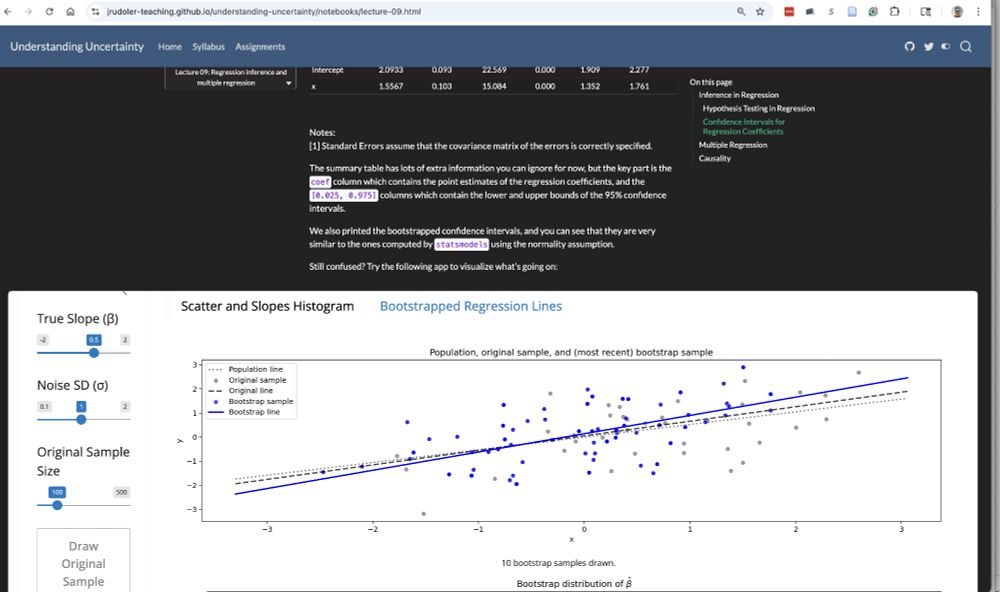
July 31, 2025 at 7:19 PM
Its a new term and a lot of us are preparing their lectures. I am a huge fan of online ways of teaching. And my student Joey Rudoler @jrudoler.bsky.social made a great online stats course. Shiny app and all. Modern take on stats. Thought some of you may appreciate.
Are you at @assc28.bsky.social #ASSC28? On Wednesday I will present a poster on the causal relationship between choice history biases and catecholamines (noradrenaline / dopamine). With @donnerlab.bsky.social et al.
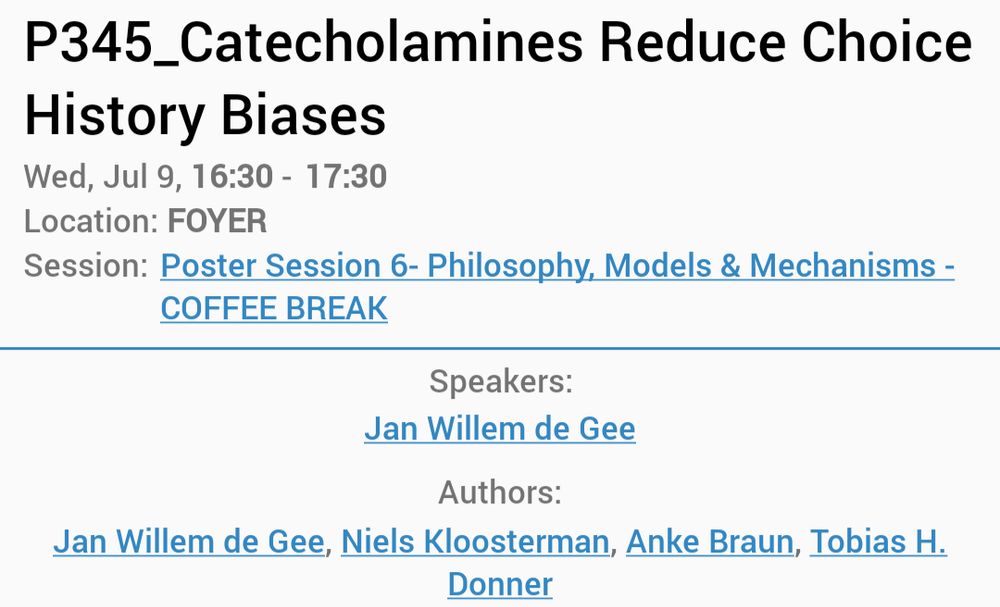
July 7, 2025 at 9:09 AM
Are you at @assc28.bsky.social #ASSC28? On Wednesday I will present a poster on the causal relationship between choice history biases and catecholamines (noradrenaline / dopamine). With @donnerlab.bsky.social et al.
Are you at @assc28.bsky.social #ASSC28? Later, @stijnnuiten.bsky.social will present exciting cross-species results on the interaction between latent behavioral states, pupil-linked arousal, and V1 activity. Great collab w/ @psterzer.bsky.social @svangaal.bsky.social @pennartz.bsky.social et al.

July 7, 2025 at 9:05 AM
Are you at @assc28.bsky.social #ASSC28? Later, @stijnnuiten.bsky.social will present exciting cross-species results on the interaction between latent behavioral states, pupil-linked arousal, and V1 activity. Great collab w/ @psterzer.bsky.social @svangaal.bsky.social @pennartz.bsky.social et al.
Reposted by de Gee lab
Thrilled to see our TinyRNN paper in @nature! We show how tiny RNNs predict choices of individual subjects accurately while staying fully interpretable. This approach can transform how we model cognitive processes in both healthy and disordered decisions. doi.org/10.1038/s415...
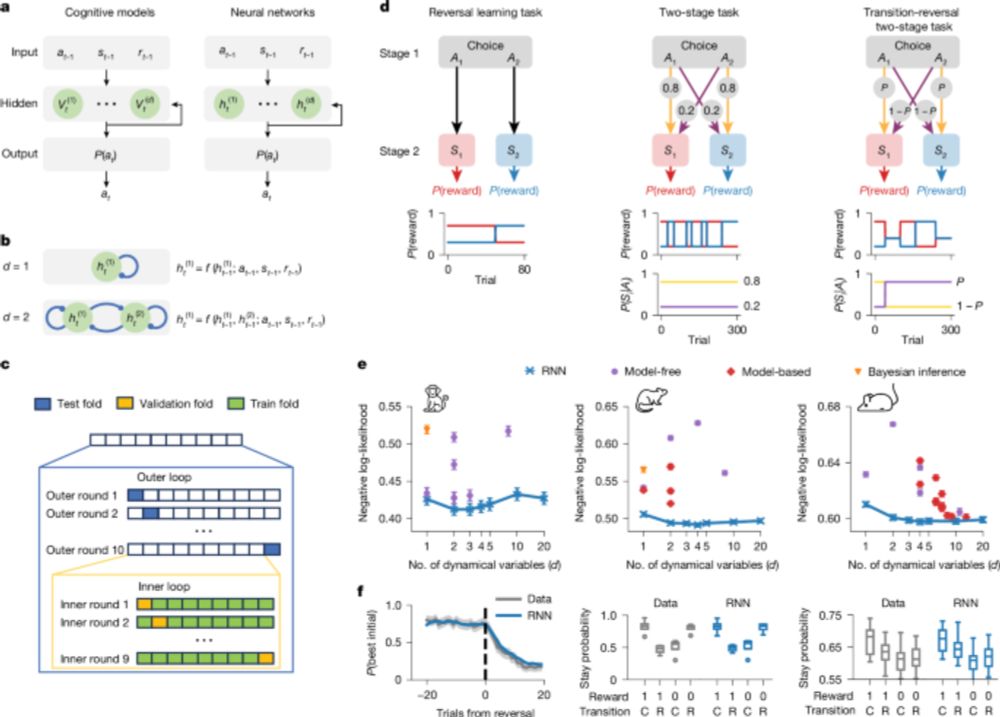
Discovering cognitive strategies with tiny recurrent neural networks - Nature
Modelling biological decision-making with tiny recurrent neural networks enables more accurate predictions of animal choices than classical cognitive models and offers insights into the underlying cog...
doi.org
July 2, 2025 at 7:03 PM
Thrilled to see our TinyRNN paper in @nature! We show how tiny RNNs predict choices of individual subjects accurately while staying fully interpretable. This approach can transform how we model cognitive processes in both healthy and disordered decisions. doi.org/10.1038/s415...
Reposted by de Gee lab
1/ New paper by Hame Park, (@AraziAyelet), Bharath Talluri, Marco Celotto, Stefano Panzeri, Alan Stocker & Tobias Donner published in Nature Communications – “Confirmation Bias through Selective Readout of Information Encoded in Human Parietal Cortex”: rdcu.be/etlR7. Here is a summary:
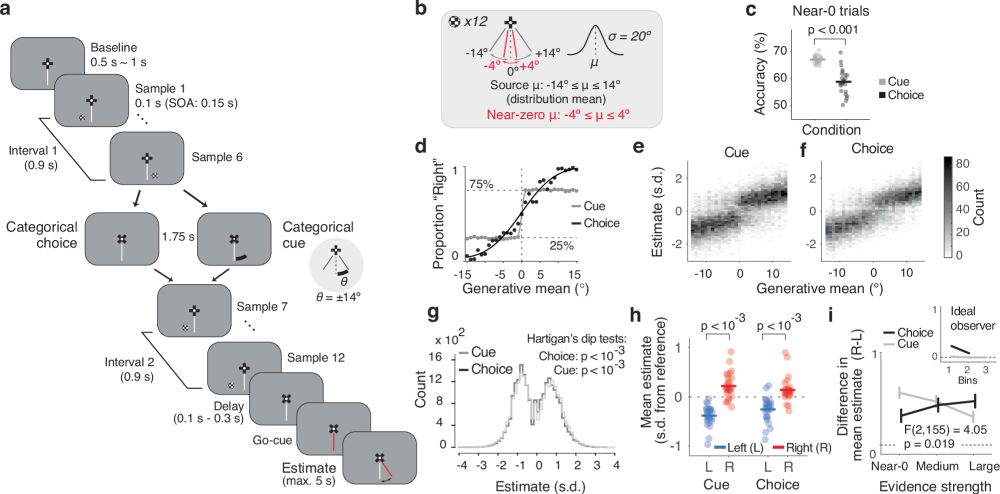
Confirmation bias through selective readout of information encoded in human parietal cortex
Nature Communications - People often discard incoming information when it contradicts their pre-existing beliefs about the world. Here, the authors show that this discarded information is precisely...
rdcu.be
June 27, 2025 at 1:35 PM
1/ New paper by Hame Park, (@AraziAyelet), Bharath Talluri, Marco Celotto, Stefano Panzeri, Alan Stocker & Tobias Donner published in Nature Communications – “Confirmation Bias through Selective Readout of Information Encoded in Human Parietal Cortex”: rdcu.be/etlR7. Here is a summary:
Reposted by de Gee lab
This is a super cool way of studying learning, effort, and foraging www.biorxiv.org/content/10.1...

A progressive ratio task with costly resets reveals adaptive effort-delay tradeoffs
The Progressive Ratio (PR) schedule is a popular test for measuring the motivational value of a reinforcer, in which subjects must exert an increasing amount of work to obtain each successive reward. ...
www.biorxiv.org
June 28, 2025 at 5:33 PM
This is a super cool way of studying learning, effort, and foraging www.biorxiv.org/content/10.1...

